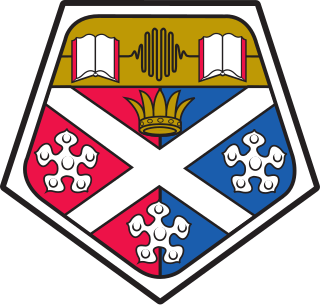
The University of Strathclyde is a public research university located in Glasgow, Scotland. Founded in 1796 as the Andersonian Institute, it is Glasgow's second-oldest university, having received its royal charter in 1964 as the first technological university in the United Kingdom. Taking its name from the historic Kingdom of Strathclyde, its combined enrollment of 25,000 undergraduate and graduate students ranks it Scotland's third-largest university, drawn with its staff from over 100 countries.

The Rottenrow is a street in the Townhead district of Glasgow, Scotland. One of the oldest streets in the city, it underwent heavy redevelopment in the 20th century and now forms part of the University of Strathclyde's John Anderson Campus. The street runs along the summit of a drumlin known historically as Balmanno Brae, although this name has long fallen from use.

Cowcaddens is an area of the city of Glasgow, Scotland. It sits directly north of the city centre and is bordered by the newer area of Garnethill to the south-west and Townhead to the east.

Townhead is a district within the city of Glasgow, Scotland. It is one of Glasgow's oldest areas, and contains two of its major surviving medieval landmarks – Glasgow Cathedral and the Provand's Lordship.

Houston, is a village in the council area of Renfrewshire and the larger historic county of the same name in the west central Lowlands of Scotland.

The Royal College of Science and Technology was a higher education college that existed in Glasgow, Scotland between 1887 and 1964. Tracing its history back to the Andersonian Institute, it is the direct predecessor institution of the University of Strathclyde. Its main building on George Street now serves as one of the major academic and administration buildings of the University of Strathclyde.

Broomhill is a district in the West End of the city of Glasgow, Scotland. North of the River Clyde, it is bounded by the districts of Thornwood and Partick to the south, Hyndland to the east, and Jordanhill, Scotstoun and Victoria Park to the west.

The Merchant City, a new name introduced through urban renewal by the Scottish Development Agency and the city council in the 1980s is one part of the metropolitan central area of Glasgow. It commences at George Square and goes eastwards reaching Glasgow Cross, in the centre of Glasgow, Scotland. The eastern fringe of the Merchant City contains part of Glasgow's original medieval street plan, which stretches northwards towards neighbouring Townhead.
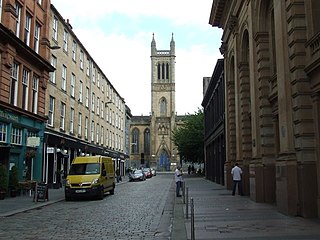
Candleriggs is a street in the city of Glasgow, Scotland. It is located in the Merchant City area of the city centre.
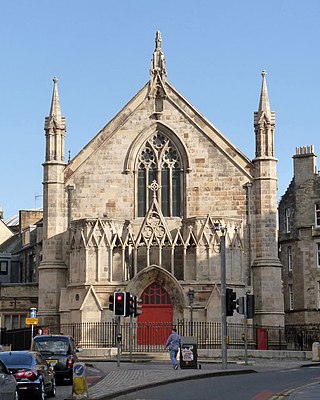
Bedlam Theatre is a theatre in the Old Town of Edinburgh, Scotland. The building was completed in 1848 for the New North Free Church. After closing as a church in 1941, the building served as a chaplaincy centre and then a store for the University of Edinburgh before reopening in 1980 as the student-run theatre of Edinburgh University Theatre Company (EUTC), operating during Edinburgh Fringe festival as venue 49.
The Bruce Report is the name commonly given to the First Planning Report to the Highways and Planning Committee of the Corporation of the City of Glasgow published in March 1945. It influenced an intensive programme of regeneration and rebuilding efforts which took place in the city and surroundings from the mid-1950s and lasted until the late 1970s. The author was Robert Bruce, Glasgow Corporation Engineer at the time.

The Livingstone Tower is a prominent high rise building in Glasgow, Scotland and is a part of the University of Strathclyde's John Anderson Campus. The building was named after David Livingstone. The address of the building is 26 Richmond Street, Glasgow.
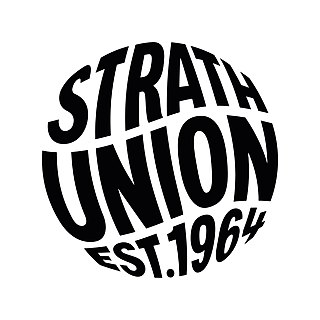
Strathclyde Students' Union (Strath Union) is the representative body for students of the University of Strathclyde, Glasgow, Scotland, since its founding in 1964.

The Ramshorn, is a deconsecrated church building located on Ingram Street in the Merchant City area of Glasgow, Scotland. It is home to SCILT, Scotland's National Centre for Languages and the Confucius Institute for Scotland's Schools (CISS), both centres within the University of Strathclyde. The building is owned by the University, which bought the church in 1983 and used it as a theatre and performance space from 1992 until 2011.

The James Weir Building is an academic building in Glasgow City Centre, Scotland, United Kingdom and is part of the University of Strathclyde’s John Anderson Campus, situated between the Townhead and Merchant City districts of the area. It was completed in two stages between 1956 and 1964 as an extension to the Royal College Building. It is the third largest building on the John Anderson Campus in terms of overall floor area after the Royal College and the Curran Building. In addition, the stair and lift tower on the south east corner of the building is the second highest structure on the campus after the Livingstone Tower, and is highly visible throughout the eastern side of the city centre.
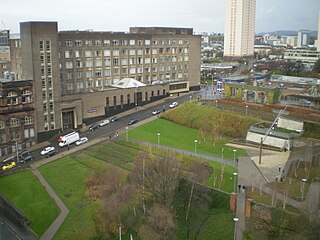
The John Anderson Campus, the main campus of The University of Strathclyde, is located in Glasgow, Scotland. The campus is self-contained in its own area which straddles the Townhead and Merchant City districts on the north eastern side of the city centre, while being only minutes from the M8 Motorway, George Square and is located midway between Queen Street Railway Station and High Street station on the North Clyde Line.

The Ramshorn Cemetery is a cemetery in Scotland and one of Glasgow's older burial grounds, located within the Merchant City district, and along with its accompanying church, is owned by the University of Strathclyde. It has had various names, both official and unofficial: North West Parish Kirkyard; St David's Kirkyard; and Ramshorn and Blackfriars. The latter name tells of its link to Blackfriars Church, linking in turn to the pre-Reformation connection to the Blackfriars Monastery in Glasgow.

The Barony Hall,, is a deconsecrated church building located on Castle Street in the Townhead area of Glasgow, Scotland, near Glasgow Cathedral, Glasgow Royal Infirmary and the city's oldest surviving house, Provand's Lordship. It is built in the red sandstone Victorian neo-Gothic-style. The original or Old Barony Church was built as a part of the Barony Parish in Glasgow by architect, James Adams. It opened in 1799 and served ceremonial and other congregational purposes. The replacement for the old building was designed by J. J. Burnet & J. A. Campbell and raised in 1889, and incorporated architectural artifacts from the old church and a number of other relics.

The Wolfson Centre is an academic building within the city of Glasgow, Scotland and part of the University of Strathclyde's John Anderson Campus.




















